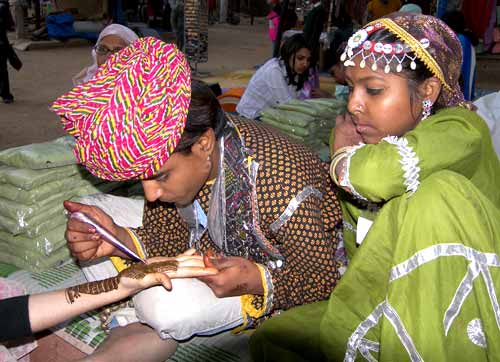source{google.com.pk}
For centuries, mehndi the art of henna painting on the body — has been practiced in India, Africa, and the Middle East, where the henna plant is believed to bring love and good fortune, and to protect against evil. Mehndi is traditionally practiced for wedding ceremonies, during important rites of passage, and in times of joyous celebration. A paste made from the crushed leaves of the henna plant is applied to the skin, and when removed several hours later, leaves beautiful markings on the skin that fade naturally over 1 to 3 weeks. Henna body art is an age-old tradition, practiced in countries throughout the world. Natural Henna Art provides traditional mehndi patterns as well as eclectic contemporary art and original design work for all types of events, ranging from weddings to corporate parties to private gatherings and birthday parties. Natural Henna Art also showcases mixed media canvas artwork throughout the Bay Area. Photography may also be provided to document your next special event.The art of henna painting on the body — has been practiced in India, Africa, and the Middle East, where the henna plant is believed to bring love and good fortune, and to protect against evil. Mehndi is traditionally practiced for wedding ceremonies, during important rites of passage, and in times of joyous celebration. A paste made from the crushed leaves of the henna plant is applied to the skin, and when removed several hours later, leaves beautiful markings on the skin that fade naturally over 1 to 3 weeks.Besides being the key ingredient in mehndi, henna has also been used to dye the manes and hooves of horses, and to color wool, silk, and animal skins, as well as men's beards. Studies of mummies dating back to 1200 BC show that henna was used on the hair and nails of the pharaohs. Until the art of mehndi became hot news in 1996, henna was mostly used in the United States as a hair dye. Widely recognized now as a wonderful way to dye the skin and to achieve the look of a tattoo, traditional henna uses and application processes have gone contemporary. Although some will always prepare their own henna paste, mehndi kits of varying quality, with foolproof instructions and convenient stencils, can be purchased in many retail and online outlets. Until the art of mehndi became hot news in 1996, henna was mostly used in the United States as a hair dye. Widely recognized now as a wonderful way to dye the skin and to achieve the look of a tattoo, traditional henna uses and application processes have gone contemporary. Although some will always prepare their own henna paste, mehndi kits of varying quality, with foolproof instructions and convenient stencils, can be purchased in many retail and online outlets (including this Web site).Practiced for five thousand years throughout India, Africa, and the Middle East, the act of painting the body with preparations made from the crushed leaves of the henna plant, whether it be in preparation for a special occasion or in celebration of a particular event, has always been done with the assumption or fervent wish that the act would engender good fortune, happy results, and good feelings.In the north and western parts of India, the desert areas where the henna plant grows, mehndi (or henna painting) is a very important part of the wedding ritual and ceremony. As the story goes, the deeper the color obtained on the skin, the longer the love between the couple will last; hence the belief that a proper mehndi application is tantamount to a prayer to the gods for everlasting love and a successful marriage. Pregnant Moroccan women in their seventh month seek out well-respected henna practitioners called hannayas in order to have certain symbols painted on their ankle, which will then be encircled with a corresponding amulet. The henna and the amulet are meant to protect both the mother and child through birth. Once the baby is born and the umbilical cord severed, a plaster of henna, water, and flour is placed on the newborn's belly button in order to ensure beauty and wealth. Those who have already come into contact with powdered henna are familiar with its undeniably special smell, a powerful and heady combination of earth, clay, chalk, and damp green leaves. In contrast, fresh henna leaves have no odor whatsoever, even when crushed between the fingers. The henna flower is delicate, petite, and four-petaled, with a profusion of slender and elongated antennas bursting from the center. The red, rose, and white variations of the blossom, which also blooms yellow, cream, and pink, emit a sweet and seductive scent reminiscent of jasmine, rose, and mignonette; hence the name Jamaica Mignonette, as henna is referred to in the West Indies. Although the plant's primary uses lie elsewhere, the flower's oil has been used as a perfume for many centuries (although its fragrant secret has yet to be popularized in the West).
Henna Artist Henna Hands Pictures Images Pics

Henna Artist Henna Hands Pictures Images Pics

Henna Artist Henna Hands Pictures Images Pics

Henna Artist Henna Hands Pictures Images Pics

Henna Artist Henna Hands Pictures Images Pics

Henna Artist Henna Hands Pictures Images Pics

Henna Artist Henna Hands Pictures Images Pics
.jpg)
Henna Artist Henna Hands Pictures Images Pics

Henna Artist Henna Hands Pictures Images Pics
Henna Artist Henna Hands Pictures Images Pics

Henna Artist Henna Hands Pictures Images Pics
No comments:
Post a Comment